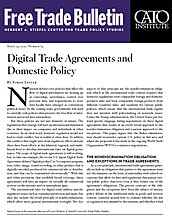1. “Agreement between the United States and Japan Concerning Digital Trade,” Office of the United States Trade Representative, October 7, 2019, Article 1(g), https://ustr.gov/sites/default/files/files/agreements/japan/Agreement_between_the_United_States_and_Japan_concerning_Digital_Trade.pdf.
2. World Trade Organization, Appellate Body Report, “Chile—Taxes on Alcoholic Beverages,” WT/DS87/AB/R, WT/DS110/AB/R, adopted December 13, 1999.
3. GATT Panel Report, “United States Section 337 of the Tariff Act of 1930,” L/6439, adopted 7 November 1989, BISD 36S/345.
4. Lothar Ehring, “De Facto Discrimination in World Trade Law: National and Most-Favoured-Nation Treatment—or Equal Treatment?,” Journal of World Trade 36, no. 5 (2002): 921–77, https://kluwerlawonline.com/journalarticle/Journal+of+World+Trade/36.5/5107794; WTO, “Chile—Taxes on Alcoholic Beverages”; and World Trade Organization, Appellate Body Report,” European Communities—Measures Affecting Asbestos and Products Containing Asbestos,” WT/DS135/AB/R, adopted on March 12, 2001.
5. General Agreement on Tariffs and Trade, Article XX: General Exceptions, chapeau.
6. See, for example, World Trade Organization, Appellate Body Report, “Korea—Measures Affecting Imports of Fresh, Chilled and Frozen Beef,” WT/DS161/AB/R, WT/DS/169/AB/R, adopted December 11, 2000, paras. 164–66; and World Trade Organization, Appellate Body Report, “United States—Measures Affecting the Cross-Border Supply of Gambling and Betting Services,” WT/DS285/AB/R, adopted April 7, 2005, paras. 306–07.
7. See, for example, World Trade Organization, Appellate Body Report, “United States—Import Prohibition of Certain Shrimp and Shrimp Products,” WT/DS58/AB/R, adopted October 12, 1998, para. 136; and World Trade Organization, Appellate Body Report, “China—Measures Related to the Exportation of Rare Earths, Tungsten and Molybdenum,” WT/DS431/AB/R, WT/DS432/AB/R, WT/DS433/AB/R, para. 5.105.
8. Trans-Pacific Partnership, “Chapter 14: Electronic Commerce,” Office of the United States Trade Representative, Article 14.4, para. 1, https://ustr.gov/sites/default/files/TPP-Final-Text-Electronic-Commerce.pdf.
9. Comprehensive and Progressive Agreement for Trans-Pacific Partnership, “Chapter 14: Electronic Commerce,” New Zealand Ministry of Foreign Affairs and Trade, https://www.mfat.govt.nz/assets/Trade-agreements/TPP/Text-ENGLISH/14.-Electronic-Commerce-Chapter.pdf; and Digital Economy Partnership Agreement, New Zealand Ministry of Foreign Affairs and Trade, Article 3.3, https://www.mfat.govt.nz/assets/Uploads/DEPA-Signing-Text-11-June-2020-GMT.pdf.
10. United States-Mexico-Canada Agreement (USMCA), “Chapter 19: Digital Trade,” September 2018 version, Article 19.4, https://www.worldtradelaw.net/usmca2018/USMCApre-scrubfulltext.pdf.
11. United States-Mexico-Canada Agreement (USMCA), “Chapter 19: Digital Trade,” November 2018 version, Article 19.4, https://www.worldtradelaw.net/usmca2018/19_Digital_Trade.pdf. The same language appears in the U.S.-Japan Digital Trade Agreement in Article 8.1. See “Agreement between the United States of America and Japan Concerning Digital Trade,” https://ustr.gov/sites/default/files/files/agreements/japan/Agreement_between_the_United_States_and_Japan_concerning_Digital_Trade.pdf.
12. Simon Lester, “Is Non-Discrimination in U.S. Digital Trade Agreements Nationality-Based?,” International Economic Law and Policy Blog, March 16, 2021.
13. World Trade Organization, “WTO Electronic Commerce Negotiations: Consolidated Negotiating Text—December 2020,” INF/ECOM/62/Rev.1 December 14, 2020, Section B.1, https://www.bilaterals.org/IMG/pdf/wto_plurilateral_ecommerce_draft_consolidated_text.pdf.
14. U.S.-Japan Digital Trade Agreement, Article 11.2, https://ustr.gov/sites/default/files/files/agreements/japan/Agreement_between_the_United_States_and_Japan_concerning_Digital_Trade.pdf; and USMCA, “Chapter 19: Digital Trade,” Article 19.11, para. 2, https://ustr.gov/sites/default/files/files/agreements/FTA/USMCA/Text/19-Digital-Trade.pdf.
15. World Trade Organization, “WTO Electronic Commerce Negotiations: Consolidated Negotiating Text—December 2020,” Section B.2, para. 6.
16. “WTO Electronic Commerce Negotiations,” Section B.2, para. 6.

